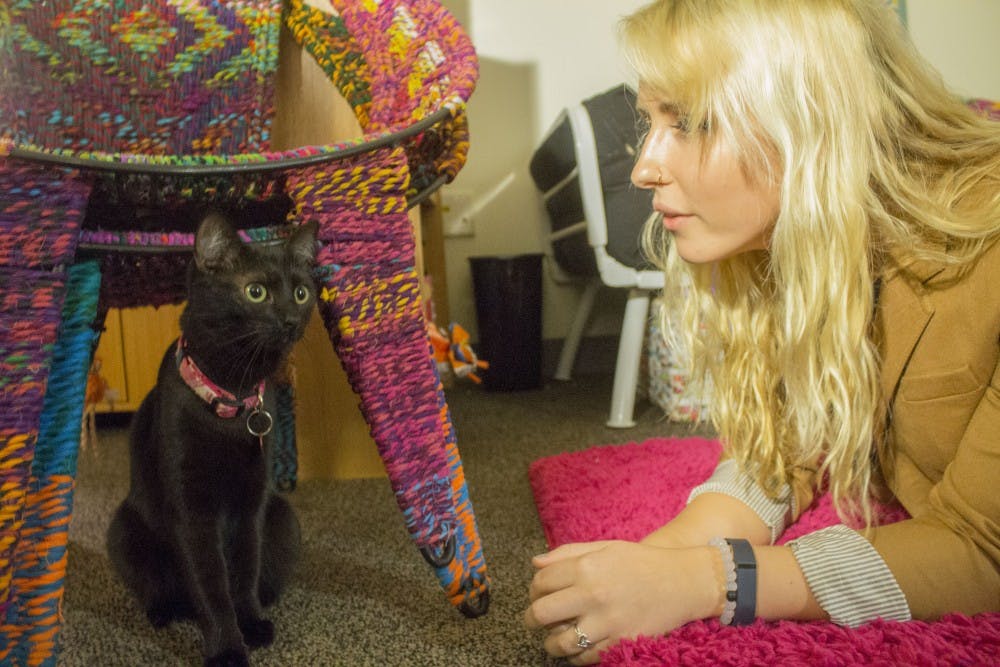Last semester, as the cold, blustery January weather waged outside her window, Lauren Smith withdrew into her room; dismissing the “funk” she was in as no more than a result of the dreary seasonal conditions.
But slowly a week went by, then two weeks, then three and Smith was still cooped up in her room. She began skipping classes, avoided plans with friends and was terrified to even consider leaving the confines of her room. “I was embarrassed because I just felt lazy,” Smith said. “But then I would sit in my room and cry all the time but I didn’t know why.”
Smith’s parents suggested she see a doctor and short thereafter Smith was diagnosed with Generalized Anxiety Disorder and Depression.
Generalized Anxiety Disorder, commonly known as GAD, is defined as persistent, excessive and unrealistic worry about everyday things by the Anxiety and Depression Association of America (ADAA). For some people who struggle with anxiety, just the thought of getting through the day can cause one to anticipate disaster.
Many individuals often experience their first “episode” by the age of 22 according to a study by the ADAA. Thus making anxiety one of the most common mental health problems among college students, like Smith. The pressures of college and early adulthood can be stressful for anyone, but for a student wrestling with anxiety, the need to do well in school and maintain a social life can become overwhelming. For these students, it is the relationships and social bonds they forge on campus that help them cope.
Now in her junior year, Smith admitted that she still has relapses and is still trying to figure out how to handle her anxiety.
“It’s kind of like a daily thing,” Smith said. “A lot of my problem is that I internalize it.”
In terms of social interaction with others, Smith said that what can set her off isn’t so much something someone may say, but rather the anticipation of how they will react or worse, that they won’t understand.
“I don’t say ‘Oh so and so said this to and that’s what made me upset,’ I think, ‘This is how they’re going to react, they’re just going to think that I’m lazy ‘cause I can’t get out of bed today,” Smith said. “Or they’re going to be mad because I’m not going to do my part of the project. They’re not going to really understand what else I’m going through.”
It is for this reason that when she does have a rough day, Smith finds it easier to talk about her issues with people who’ve had similar struggles with mental health like her friend and confidant David Haggerty.
“If I’m having a really shitty day and I text David and say ‘I can’t get out of bed,’ he’s really good about saying ‘Okay, well you don’t have to get out of bed, but why don’t you set a small goal?’” Smith said. “I don’t have to justify the fact that I can’t get out of bed. It’s comforting in that sense.”
Haggerty, a senior who has had his own battles with depression and anxiety, also said for a lot of individuals struggling with anxiety the main issue is self-stigmatization and internalization. Leading them to resort to personal coping mechanisms.
“You do your best on a daily basis to conceal the fact that you have a mental illness,” Haggerty said. “It’s not something that’s very visible but then when someone says something to you it’s almost like a ‘oh shit they figured it out’ moment. Everything you’ve been trying to do to cover it up has now been exposed and you just feel really vulnerable.”
Haggerty said he understands that it can be easy for others to get angry, especially when one has responsibilities to uphold and their anxiety renders them unable to complete their part. For example, being in a group project for a class.
“A lot of people that’s the response that they go for. They get upset they get angry,” Haggerty said. “There’s things that you have to do, there are obligations that you have to meet, but you know you’re not physically sick, ‘I can’t see that you’re sick, so why can’t you meet these things?’”
***
For freshman Olivia Null, that emotional support comes in the form of a 9-month old shorthaired black domestic cat named Orchid.
Null was first introduced to the idea of a therapy pet when she was lying in a community hospital after admitting to her high-school art teacher that she was contemplating writing a suicide note. A doctor who attended to Null suggested she get something that gives her purpose. It was then that Null decided on the name Orchid.
“The name, the flower, the pink orchid, symbolizes friendship, happiness, joy and new beginnings, which were all things that I needed at the time,” Null said.
After adopting Orchid this past May, Null who had already been accepted into IU began the registration process with IU Disability Services and Residential Programs and Services.
According to RPS guidelines Null would have to be placed on a floor where there were no residents that were allergic to cats and she would have to clear it with her roommate. Orchid would also have to be litter and leash trained and would not be allowed outside Null’s room.
“Taking care of her has given me a taste of putting something else before you and adapting to it,” Null said.
Null admitted that with Orchid’s curious and lively personality it’s hard to be in a bad mood around her.
“She’s made me so much happier,” Null said. “Not every day down here has been perfect, I love IU, and I’m a lot better than where I was, but I definitely can dip. I need her.”
***
Smith, Haggerty and Null all said that every now and then they run into some challenges when talking to people about their anxiety; from someone asking “Why can’t you just stop being sad?” to people carelessly claiming they have GAD because they get anxious about exams and had a panic attack once or to saying they should fake a disorder in order to bring their pet to school.
The solution is creating a space to facilitate positive discussion, bringing people with mental health problems together with people who don’t, as a means of addressing stigmas and misconceptions about anxiety and other mental illnesses.
“Talking is big,” Smith said. “It’s better to acknowledge that there’s a problem rather than wait around rationalize the issue.”
As a result, the focus gets shifted from simply educating people about what mental illness is to showing what mental illness looks like in real life and creates an environment where people feel comfotable talking about it.
“Unless you look really carefully, you can’t see it,” Haggerty said. “But when you start to talk to these people and when you get to learn about these people, you’ll realize that they’re not that much different at all.”
Director of Counseling and Psychological Services, Nancy Stockton, said that in addition to providing students with individual counseling sessions and cognitive evaluation, such as examining helpful and anxiety provoking thinking patterns, CAPS reinforces basic self-care concepts such as exercising, eating right and getting enough sleep.
“They seem basic but within the college student lifestyle they can be overlooked,” Stockton said.
In addition to having small groups of friends they can talk to, Haggerty and Smith said they found support through their work with IU’s U Bring Change 2 Mind campaign.
Null said that exercise has been a great help with dealing with her anxiety and depression. She stressed the importance of encouraging people who know of someone dealing with similar struggles to stay in contact and hold them accountable.
“Keep them talking, keep them involved, encourage them to exercise, in general be a positive person around them,” Null said. “Remind them of the positive things in their life. Because as soon as someone stops talking it’s when it gets dangerous.”






